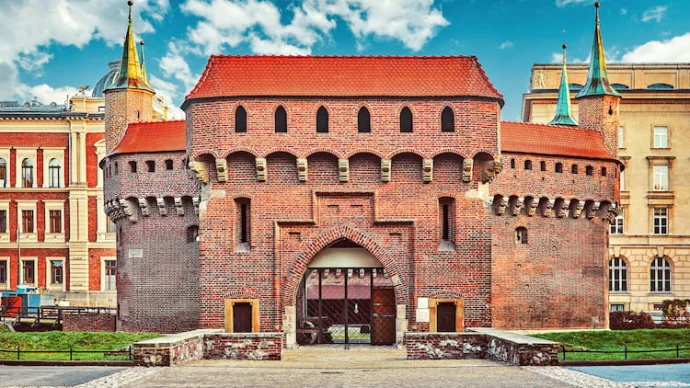
About Krakow Cloth Hall
Cloth Hall or Sukiennice is a medieval market building in Krakow, Poland. Originally opened in the fourteenth century, Cloth Hall was given a Renaissance refurbishment in the 16th century. The arcades which can be seen at Cloth Hall today were added in the 19th century.
The ground floor of Cloth Hall still operates as a market today while the Małopolska Contemporary Art Gallery and 19th Century Polish Art Gallery reside on its upper floors.
Krakow Cloth Hall history
In the heart of the Krakow Old Town, the Cloth Hall, or Sukiennice as referred to locally, is one of the most important buildings in the district and was once of the heart of Krakow’s medieval clothing trade.
At beginning of the 14th century Krakow was a major trade hub of eastern Europe and merchants came from all over the region to trade their wares in the middle of the city centre. Around this time planners decided to build permanent covering over the main lines of stalls on the plaza that would allow trade in all weather, especially with the harsh Polish winters. This structure became the first iteration of the Cloth Hall.
Around the middle of the 16th century a major fire damaged the Cloth Hall beyond repair. It was then rebuilt in a redevelopment project that shaped the building in its noteworthy renaissance style. In this period, the city and Cloth Hall enjoyed prosperity.
After Krakow lost its status as the royal capital of Poland in 1569 when the court was moved to Warsaw, the Cloth Hall and much of Old Town entered a long period of decline.
Towards the end of the 19th century, there was a thorough renovation resulting in the building as it stands today. Arcaded galleries were added, the facade was totally reconstructed, the upstairs museum space as created and the designs of Polish architect Tomasz Pryliński were used to give the whole structure an ochre veneer.
Krakow Cloth Hall today
The hall has hosted many distinguished guests over the centuries and has been used to entertain monarchs and dignitaries, such as Charles, Prince of Wales and Emperor Akihito of Japan, who was welcomed there in 2002. In the past, balls were held there, most notably after Prince Józef Poniatowski had briefly liberated the city from the Austrians in 1809.
In 1976, the band The Who played an “intimate” gig for Polish and British embassy workers, working in Poland.
On the upper floor of the hall is the Sukiennice Museum division of the National Museum, Kraków. It holds the largest permanent exhibit of the 19th-century Polish painting and sculpture, in four grand exhibition halls arranged by historical period and the theme extending into an entire artistic epoch.
Today, the Cloth Hall still bustles with the energy of countless sellers and traders, only now its craft trinkets, amber, souvenirs and novelty shot glasses that take centre stage. It also still reigns as one of the most recognisable features of the Main Market Square.
Getting to Krakow Cloth Hall
The Cloth Hall dominates the bustling main market square in Old Town and is accessible by bus and tram.
Featured In

Poland Historic Sites
Explore the diverse history of Poland, from the great Barbakan to the beautiful Wilanow Palace, through our guide to 10 historic sites, landmarks and monuments to see when in Poland.




















